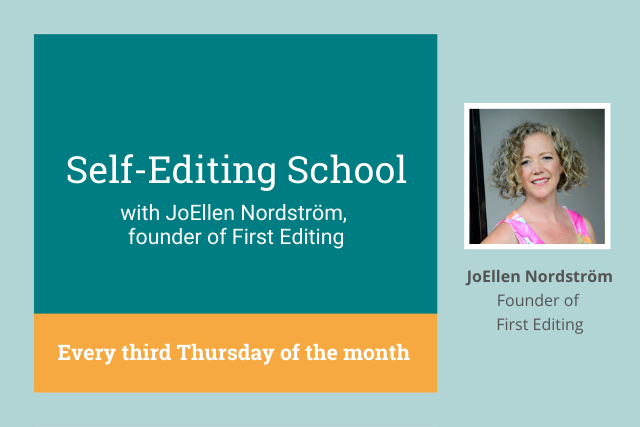Watch JoEllen's live training on Self-Editing Your Novel to Improve Readability, then keep reading for more tips:
On to the article.
Self-Editing Your Novel to Improve Readability

Welcome to Self-Editing School! To begin self-editing your novel, I assume you have completed your manuscript. If not, and you are still struggling with your outline and writing, there are some excellent fiction writing tools out there such as OneStopforWriters.com, which has an absolutely amazing system for creating all the details and sections of your book. Plus, their online writing tool works nicely with ProWritingAid’s online editor.
Once you have created your manuscript and are self-editing, then it is important to start with the big picture of your manuscript. You want to ensure that your story is strong and presents well while engaging your audience. I would encourage you to learn and use the same techniques that our professional editors use behind-the-scenes. By evaluating the primary elements of plot, characters, and settings, you will improve your current manuscript. You will also learn how to write a better manuscript in the future.
When we are editing your story, we focus on 38 Story Elements. To keep this a bit more compact so you can start self-editing immediately, I will group these into the higher focus categories and briefly cover the details within each of those. (I will also gladly answer your questions during our online Self-Editing School webinars in the future.)
I am including a link to an entire online podcast series and playlist of YouTube videos where we have discussed each of the 38 Story Elements more in-depth while limiting each podcast to approximately 5-10 minutes. Check those out for better clarity and more in-depth, individual instructions for each element.
Remember to subscribe to the podcast so you don’t miss any upcoming episodes.
Start with Self-Editing
To strengthen the readability of your novel through self-editing, I recommend you conduct an in-depth review of the entire 38 Story Elements we cover today in your manuscript. However, to make your first steps easy and encouraging, we will begin with the three main categories of plot, character, and setting. Of course, how you structure these elements to create your overall story is vital, so we will touch a bit on this as well.
By ensuring you use and vary each of these three primary story elements accurately, you can create a powerful story which keeps your readers returning and again. Plus, as you master your craft as a wordsmith, you will find it easier to write more and more novels in your series for your growing, engaged audience.
Thus, everyone wins.

Self-Edit Your Plot into Individual Scenes
Plot is your series of events which are the foundation of your story. We break these events down into individual scenes. How you use each scene in your story is vital to determining the strength of your plot.
When you are self-editing your plot, I recommend that you define each scene by giving it a name and outlining its purpose. Describe it with the theme or action which occurs within that individual scene so you can then determine where it fits into your overall story arc.
Note other basic plot factors including your types of opening and closing scenes, entry and exit hooks, along with how you anchor your scenes. Each of these elements strengthen your plot. Continuously vary these details to keep it fresh and engaging.
Once you have covered these basic plot elements, you can test your use of tension, conflict, revelations, backstories, flashbacks, actions, and sequels to drive your story. Ensure you effectively use each of these elements to strengthen your writing.
Finally, review each individual scene to ensure it has a middle and climax to keep your readers engaged.
I also recommend that you keep notes regarding the scene’s overall word count to ensure balance in the overall manuscript’s presentation.
Basic Plot Elements
1. Scene name
2. Story arc
3. Purpose of a scene (only known after reading entire story)
4. Opening type
5. Closing type
6. Anchored
7. Entry hook
8. Exit hook
Advanced Plot Elements
9. Tension
10. Conflict
11. Revelation
12. Backstory
13. Flashback
14. Scene middle
15. Scene climax
16. Action/sequel
17. Reader knowledge gained
Keeping thorough notes based upon the 38 story elements lists helps you discover the key events in your plot. You will see your strengths in tension and resolution while also locating any weaknesses within repetitive writing patterns. This will be intense your first time. However, it will become more second-nature when writing your next novel.
Evaluate Your Characters
Characters are the driving force in your story. They are your inspiring heroes and evil villains which capture your readers’ attention. It is important you develop fully rounded and engaging people with intriguing attributes and weaknesses to keep everyone’s attention.

To begin self-editing your fully outlined and developed characters, start by creating a list of all your characters in your manuscript. Then go to each scene and note all characters taking part and mentioned within it. Determine how they fit (or don’t) into your overall plot by reviewing how often you include them and what are their contributing actions in each scene.
Pay special attention to how you describe, introduce, and interact with your characters. Assess how often they appear in the various scenes and in contrast with each other and the character’s significance to the story. Ensure that names are not confusing for the readers.
Basic character elements to note include determining which character’s point of view is being used in each scene to determine the overall structure of your story. Ensure that it is clear and maintained steadily throughout the scene. Determine the goal of that character’s point of view. If it is unclear, the scene is weak.
After you have assessed the basic character elements, note the character’s internal goals, how they relate to the overall plot, what the dangers are if they fail, and how that affects the individual characters, protagonists, and overall plot. Determine what knowledge the characters gain from the scene and if the character is in motion to contribute to the action and tension in the overall story.
Basic Character Elements
18. List of character per scene
19. Point of View (POV)
20. POV goal
Advanced Character Elements
21. POV internal goal
22. Goal related to plot
23. What if goal fails
24. Impact on POV character
25. Impact on protagonist
26. POV knowledge gained
27. Character in motion
Test every scene’s characters from these various aspects to determine any overlooked areas you can strengthen. Keep thorough notes and a checklist to ensure you cover every element.
Strengthen Your Setting
Setting creates the background, mood, tension, and color for your story. It can strengthen or detract from your characters and plot. Thus, it is important to always effectively cover the basic setting elements within each scene and learn how to conquer the advanced elements as a pro.
Again, you must review and take notes for every scene in your manuscript so you can test the use of setting within your novel. For every scene, determine the location, date and times, relevant objects, and the use of all the senses. Ensure they are present and used for emotional impact in the scene and contribute to the overall story arc.
Important things to note when testing these elements are to ask yourself if there is too much or too little description, if the details anchor the setting, and if they match the point of view from which the scene is being described.

Remember to avoid cliches and add variety to prevent repetition. Ensure the details of setting highlight emotions, assist conflict, tension or characterization, set the mood, and support the necessary pacing of the story.
Advanced setting elements include determining if you should combine a scene or split it into different locations (and possibly separate scenes). Also, review the use of weather in your scenes to determine how it supports the mood, plot or characterization.
Basic Setting Elements
28. Location
29. Dates and times
30. Objects
31. Sight
32. Smells
33. Sounds
34. Tastes
35. Touch
36. Emotional impact
Advanced Setting Elements
37. Location split
38. Weather
Yes, this step again requires reviewing and keeping a very thorough list and advanced notes for every scene. It is this very comprehensive method professional editors use when editing your manuscript. Thus, I recommend you become familiar with this process as it allows you to learn better writing and self-editing skills.
Improve Your Readability via Your Story’s Structure
The last important technique for basic self-editing skills is assessing your story structure. Combine the details of your plot, characters, and settings to create your overall story arc. When you have analyzed the individual details of every scene, you can then add, remove, and reassemble your story so it becomes stronger in its entire presentation.
With your defined and strengthened scenes you can easily locate your inciting incident, the significant plot points, the climax, and the resolution. If any area is weak or not obvious, you now have an effective method to strengthen the various structural areas. If you are still struggling, you also know exactly what help to request from your professional editor. Either way, you are becoming a very educated and well-rounded writer.
The 38 Story Elements
By learning how to identify and address each of the 38 story elements, you now have the foundation for self-editing and improving your manuscript’s readability. You can test the primary areas of plot, setting, and characters to strengthen your story and better engage your readers. You are ready to use these elements to assess the overall structure and presentation of your novel’s story arc.
Keep writing and revising so that your story transforms from good to great!


